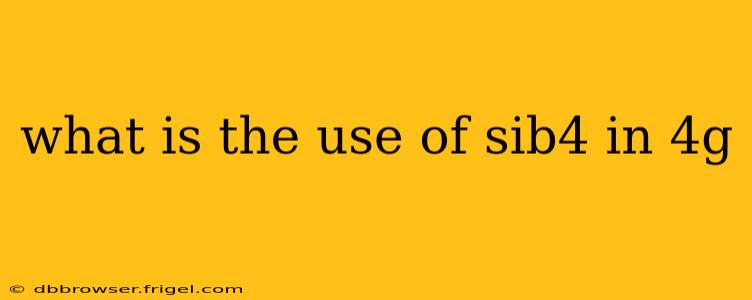What is the Use of SIB4 in 4G?
SIB4, or System Information Block 4, plays a crucial role in the 4G LTE (Long Term Evolution) network by providing essential information to user equipment (UE), which are essentially your smartphones and other mobile devices. It's a broadcast message that helps devices seamlessly connect and operate within the network. Unlike other SIBs (System Information Blocks) that provide fundamental network parameters, SIB4 focuses specifically on intra-frequency cell reselection. This means it guides your device on how to switch between different cell towers within the same frequency band, optimizing network performance and call quality.
Let's delve deeper into the specifics:
What information does SIB4 contain?
SIB4 primarily contains parameters related to cell reselection, helping your device make informed decisions about which cell tower to connect to. This includes:
-
QoffsetFreq: This parameter defines the frequency offset used in the cell reselection process. It allows for a more efficient and accurate selection of neighboring cells, even if their frequencies aren't exactly the same.
-
QQualmin: This parameter sets the minimum quality threshold for a cell to be considered for reselection. It ensures that your device doesn't switch to a weaker cell unnecessarily, maintaining a stable connection.
-
Qhyst: This parameter defines the hysteresis value, which is the difference in quality measurement between the current cell and a neighboring cell before a reselection occurs. It prevents rapid and unnecessary switching between cells.
-
Threshold parameters for other measurements: Besides signal strength, SIB4 can include other measurements such as RSRP (Reference Signal Received Power), RSRQ (Reference Signal Received Quality) and other radio resource parameters. These help your device make a more comprehensive evaluation of cell quality.
How does SIB4 improve network performance?
The information in SIB4 directly impacts network performance and user experience in several ways:
-
Improved handover success rate: By providing precise reselection criteria, SIB4 minimizes dropped calls and interruptions during handovers (switching between cells).
-
Enhanced cell edge performance: Devices at the edge of a cell’s coverage area benefit significantly from SIB4's optimized reselection logic. This ensures a stable connection even in areas with weaker signals.
-
Reduced ping-pong effect: The hysteresis value (Qhyst) in SIB4 helps prevent the "ping-pong" effect, where a device rapidly switches between two cells with similar signal strength. This leads to more stable and consistent connectivity.
-
Optimized resource utilization: By guiding devices to connect to the best cell based on factors such as signal strength and quality, SIB4 optimizes network resource allocation. This can lead to improved overall network efficiency.
What happens if SIB4 is missing or incorrect?
If SIB4 is missing or contains incorrect parameters, your device might experience:
-
Frequent call drops: The device may not be able to efficiently switch between cells.
-
Reduced data speeds: The device might connect to a weaker cell with lower data throughput.
-
Increased latency: The device might experience delays in transferring data due to inefficient cell selection.
-
Poor call quality: The device might connect to a cell with poor voice quality.
In conclusion, SIB4 is a vital component of the 4G LTE network, silently working behind the scenes to ensure efficient and reliable cellular connectivity for your mobile device. Its parameters guide intelligent cell selection, optimizing performance and minimizing disruptions. Understanding its function provides valuable insight into the sophisticated workings of modern cellular networks.
